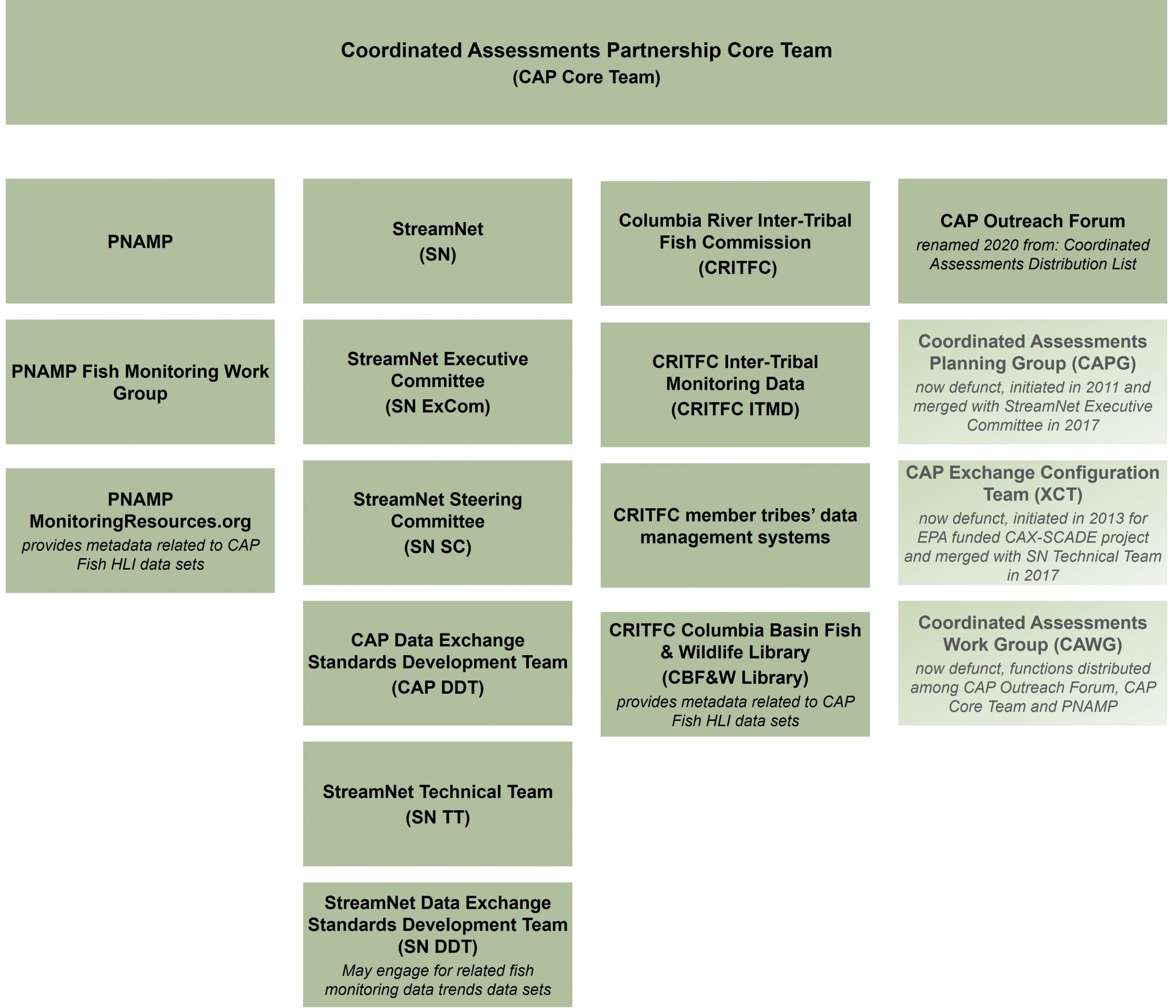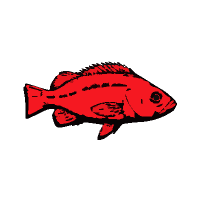CAP Process
 The Coordinated Assessments Partnership (CAP) is co-led by StreamNet and the Pacific Northwest Aquatic Monitoring Partnership (PNAMP). Each co-lead supports CAP by leveraging their expertise and resources to achieve a collaborative process that efficiently shares and provides access to standardized derived information, such as fish population high-level indicators (HLIs) and supporting metrics. The success of CAP relies strongly on participating federal, state, tribal, and other organizations.
The Coordinated Assessments Partnership (CAP) is co-led by StreamNet and the Pacific Northwest Aquatic Monitoring Partnership (PNAMP). Each co-lead supports CAP by leveraging their expertise and resources to achieve a collaborative process that efficiently shares and provides access to standardized derived information, such as fish population high-level indicators (HLIs) and supporting metrics. The success of CAP relies strongly on participating federal, state, tribal, and other organizations.
StreamNet’s data management and sharing expertise supports the technical aspects of CAP’s implementation. StreamNet supports CAP through subcontracts for StreamNet-funded data stewards, improving data management and sharing capacity of data providers, and by supporting the Coordinated Assessments Exchange (CAX) data system, including its quality control and validation processes. The StreamNet Executive Committee (SN ExCom) provides policy guidance and confirms regional priorities for the work outlined in the Five-Year Plan for the Coordinated Assessments Partnership, which is reviewed annually. StreamNet Steering Committee members are represented on the CAP Core Team and provide guidance to their organizations’ data stewards, who work to exchange data with the CAX data system. StreamNet staff serves as Chair on the CAP Data Exchange Standard Development Team (DDT), which collaboratively informs how HLI data will be shared with the CAX following data exchange standards.
PNAMP’s expertise in facilitating collaborative processes among Pacific Northwest federal, tribal, and state aquatic monitoring organizations and its success in bringing participants together to tackle topics of interest support a wide range of CAP activities. PNAMP facilitates discussions and events needed to support implementation of CAP, including informing development and refinement of HLIs through its Fish Monitoring Work Group. PNAMP also maintains the historical records of CAP and coordinates regional communication via the CAP Outreach Forum’s distribution list.
CAP’s implementation relies on the support and expertise of staff from federal, tribal, and state fish and wildlife organizations, the Columbia River Inter-Tribal Fish Commission’s Inter-tribal Monitoring Data project, and many other organizations. CAP’s CAX data system also relies on the Columbia Basin Fish & Wildlife Library to provide access to documents and reports that contain contextual supporting information for data sets.
Below we describe the roles and relationships of groups engaged in the implementation of CAP.
Roles, Responsibilities, and Relationships of Active Groups
The CAP Core Team supports discussion among partners and projects implementing the Five-Year Plan for Coordinated Assessments Partnership, directs requests for work to the appropriate CAP team or committee level, monitors implementation, reports to SN ExCom and StreamNet Steering Committee (SN SC), and generally serves to maintain forward momentum. The CAP Core Team also informs and directs periodic CAP workshops as needed. The CAP Core Team, PNAMP, and CAP Outreach Forum assumed some of the functions of the now-defunct Coordinated Assessments Work Group.
This largest CAP group is kept informed of CAP updates, including general information, when a new version of DES is published, and scheduled workshops. This group is occasionally asked to provide broader regional input on DES updates, high-level strategic guidance, work plans, CAX status, and other CAP activities in the region.
PNAMP is a co-lead of CAP and supports collaboration and coordination around aquatic monitoring, including discussion of data collection, sharing, and documentation. PNAMP contributes to CAP by facilitating monthly CAP Core Team meetings, the PNAMP Fish Monitoring Work Group, and CAP workshops. PNAMP maintains the historical records of CAP, maintains the CAP Outreach Forum distribution lists, and coordinates regional communication with the CAP Outreach Forum. PNAMP, CAP Outreach Forum, and CAP Core Team assumed some of the functions of the now-defunct Coordinated Assessments Work Group.
The PNAMP FMWG supports collaboration, communication, and coordination among fish monitoring practitioners in the Pacific Northwest for effective monitoring assessment methods and efficient data sharing. The tasks addressed by the FMWG are identified by PNAMP partners as well as through CAP and the StreamNet Program. The FMWG contributes to CAP and the StreamNet Program by providing a venue for discussing technical topics, supporting development of new data categories, and informing improvements related to CAP/StreamNet task implementation.
MonitoringResources.org is one of PNAMP’s key projects. It is a tool to document monitoring metadata. Metadata are required as part of the Coordinated Assessments Data Exchange (CAX), and HLI data sets submitted to the CAX can link to their metadata stored in MonitoringResources.org.
StreamNet is a co-lead of CAP. StreamNet is a collaborative program of Pacific States Marine Fisheries Commission (PSMFC), tribes, and federal and state fisheries management agencies that contribute data to the StreamNet data systems. StreamNet members participate on CAP committees and teams and submit HLI data to the CAX. StreamNet also engages with regional efforts (projects/partnerships) that contribute to the StreamNet Program’s goals. The data managed by StreamNet support regional decision-making as well as provide data to NOAA Fisheries’ status reviews, Northwest Power and Conservation Council Columbia River Basin Fish and Wildlife Program tools, and Bonneville Power Administration tools and reports.
The SN ExCom provides the annual high-level guidance and decision-making for CAP. This includes reviewing CAP Fish HLIs, products, and the Five-Year Plan for the Coordinated Assessments Partnership and making decisions on priorities in terms of species, populations, and indicators addressed in CAP. The now-defunct Coordinated Assessments Planning Group was merged with SN ExCom in 2017.
The SN SC directs and supervises implementation of SN ExCom decisions, with emphasis on the Columbia River Basin tasks included in the Five-Year Plan for the Coordinated Assessments Partnership and what is within StreamNet’s contracted scope of work.
The CAP DDT sets the data exchange standards (DESs) that define data structures and provide the business rules for contributing data to the CAX database. The CAP DDT consists of data management professionals and the expert biologists who are responsible for calculating indicators and metrics. The CAP DDT coordinates with other StreamNet teams (StreamNet Technical Team, StreamNet DDT) as needed.
The SN TT is responsible for the programming necessary to share data from partner data systems with the CAX and other StreamNet systems. The SN TT coordinates with the CAP DDT and SN DDT. The now-defunct CAP Exchange Configuration Team (XCT) was merged with SN TT in 2017.
The SN DDT sets the data exchange standards (DES) that define data structures and provide the business rules for contributing data to the StreamNet Fish Monitoring Data (trends) database. The SN DDT mainly consists of data managers, biologists, and programmers from the StreamNet program. The SN DDT coordinates with other StreamNet teams (CAP DDT, SN TT) as needed.
CRITFC is a partner of CAP. Its four member tribes engage in CAP processes as practicable and submit data to the CAX. CRITFC provides the tribes and the region with research, fisheries management, hydrology, and other science to support the protection and restoration of Columbia River Basin salmon, lamprey, and sturgeon. Their work is guided by the holistic principles outlined in Wy-Kan-Ush-Mi Wa-Kish-Wit (Spirit of the Salmon), the tribal salmon plan that addresses recommended restoration actions in every phase of the salmon life cycle. CRITFC’s members are the Nez Perce Tribe, the Confederated Tribes of the Umatilla Indian Reservation, the Confederated Tribes of the Warm Springs Reservation of Oregon, and the Confederated Tribes and Bands of the Yakama Nation.
The purpose of the CRITFC ITMD project is to assist CRITFC and its member tribes in the timely and accurate capture, storage, processing, and dissemination of data for management of anadromous fishes and their habitats. Coordination and integration of appropriate activities with CAP support consistent data sharing for Columbia Basin salmon and steelhead populations.
The CBF&W Library, a CRITFC program, serves as a centralized repository for the information written by tribal organizations; federal, state, and local agencies; private and contract researchers; and advocacy groups on Columbia Basin fish and wildlife projects and issues. The StreamNet program relies on the Library to provide access to documents related to the data submitted to the StreamNet data systems. A primary objective of the Library is preserving and providing access to StreamNet source and data reference documents, as well as those related to data for CAP. StreamNet and Library staff work together to ensure that all StreamNet references have complete and accessible digital records.
Information about the Coordinated Assessments Planning Group and Work Group can be found in the 2011 Columbia River Basin Collaborative Data Sharing Strategy: Salmon and Steelhead Population Abundance and Productivity Indicators.


